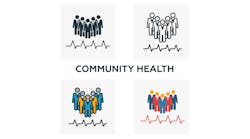How can health equity principles be incorporated into the care of seniors? A healthcare researcher offers some very specific strategies, in a Health Affairs Blog post published on January 14. In her blog, entitled “Incorporating Health Equity Into An Initiative To Transform care For Older Adults,” Faith Mitchell, an intermittent fellow at the Urban Institute, working with the Center on Nonprofits and Philanthropy and the Health Policy Center, speaks to current efforts to establish and advance principles of health equity and improve health outcomes for seniors.
After discussing some emerging and evolving efforts to address health equity for seniors, Mitchell writes that, “Furthering The John A. Hartford Foundation’s mission to transform how the care of older adults is delivered, the Age-Friendly Health Systems initiative at the IHI [Institute for Healthcare Improvement] (conducted in partnership with the American Hospital Association and the Catholic Health Association of the United States) sets standards for better care of older adults in health care systems. The standards focus on four evidence-based contributors to high-quality, cost-effective care, which are known as the ‘4Ms.’ The 4Ms refers to ‘What Matters’—knowing, and aligning care with, older adults’ health outcome goals and care preferences; ‘Medication’—using age-friendly medication and screening for the use of specific high-risk medications; ‘Mentation’—screening for and documenting depression, dementia, and delirium; and ‘Mobility’—screening for the ability to move around safely. To date, more than 1,000 care settings, including hospitals, clinics, and nursing homes, have joined the initiative,” she writes.
Further, Mitchell notes, “In 2020 the initiative’s advisory group, which includes health care practitioners, researchers, and health system leaders, organized an ad hoc equity task force with the goal of making racially and ethnically equitable care an explicit part of the 4Ms framework. From the outset the commitment was to make equity a core element of the initiative and not simply an auxiliary activity. Over several months the task force developed an equity-focused aim that could be integrated into the initiative’s existing outcome measures. These measures include 30-day readmission rates, length of stay, emergency department utilization, ratings of the hospital experience (as measured by the Consumer Assessment of Healthcare Providers and Systems [CAHPS] survey and the CAHPS Clinician and Group Survey [CG-CAHPS]), and dementia rates. An additional measure captures older patients’ access to age-friendly 4Ms care within a health system.”
And, she writes, “The equity-focused aim is that age-friendly health systems will apply the 4Ms equitably, by race and ethnicity, across their older adult patient populations. To determine whether participating organizations have met this goal, it will be necessary for them to record the racial and ethnic breakdown of their patient populations. This in itself will be a significant advance for many health care systems and care providers. It has been known for some time that health care–related data on race, ethnicity, and language were inadequate, but the COVID-19 pandemic has thrown this problem into sharp relief and increased pressure for improvements in data collection. In addition, when health care systems historically collected data on race, ethnicity, and language, it was not for quality improvement purposes, but to allow analysis to ensure compliance with civil rights provisions. By explicitly linking the rigorous collection of racial and ethnic data to quality measures, the age-friendly initiative is taking an evolutionary step forward that has potential benefits for care systems well beyond the immediate goal of measuring and improving access to 4Ms care.”
“Age-friendly” health systems, Mitchell notes, will need to analyze their outcomes, stratified by race and ethnicity, and to create and expand processes that will address disparate outcomes. “Health care systems alone cannot solve disparities that are the result of structural inequality,” she acknowledges, “but the IHI’s aspiration is in alignment with recent calls for health care to advance the needle toward health equity by incentivizing the reduction of disparities. In this instance the incentive is national recognition by the IHI as an equitable, age-friendly system. Through the Age-Friendly Health Systems initiative, the IHI has been able to scale up its own existing commitment to equity, engage a wide spectrum of national stakeholders, and, most importantly, institute a level of accountability for equitable care.”


